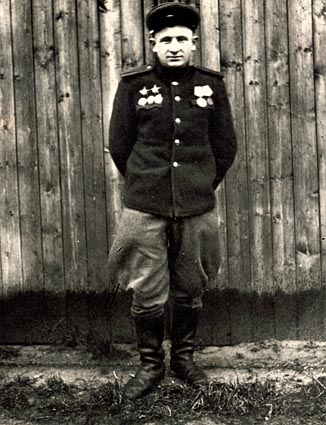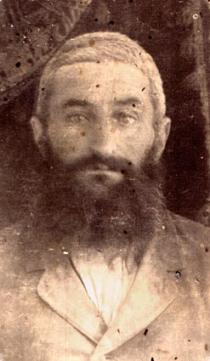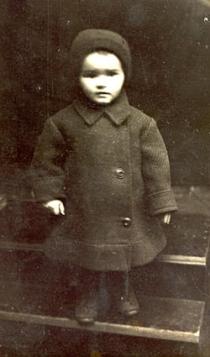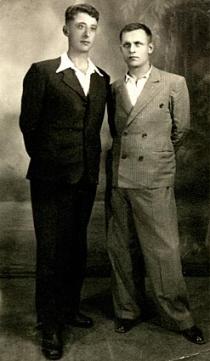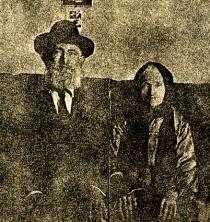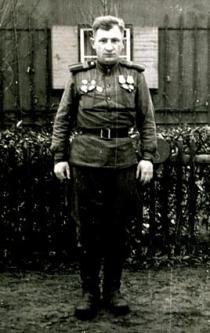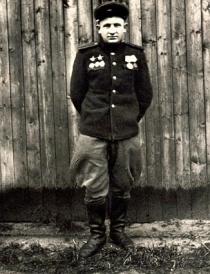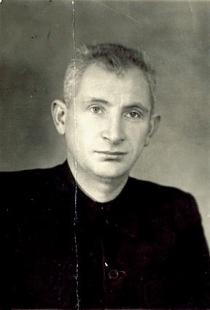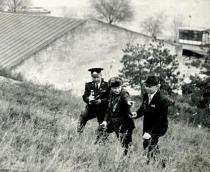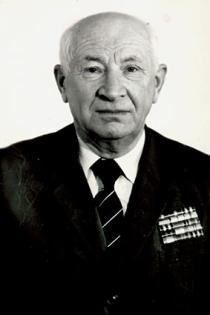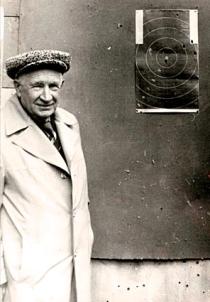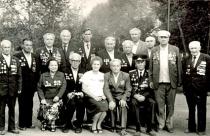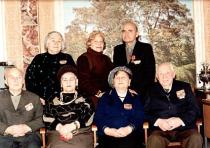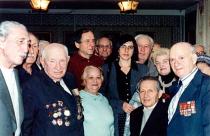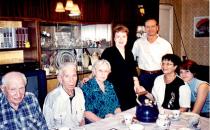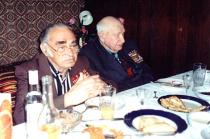This is me, Evadiy Rubalskiy, I've resumed my service duty after having medical treatment in a hospital. This photo was taken in April 1945, before our offensive on Konigsberg.
In October 1942 I was assigned to Guard artillery battalion 122 of the 51st Guard rifle division. After the Stalingrad battle our division relocated to the vicinity of Yelets town in early March 1943. Our army was ordered to relocate from the Central front to strengthen the Voronezh front. We had to keep the important Belgorod direction and get prepared to strike powerful counterblows, shield Kursk and support deployment of the 1st tank army. We were to cover 150 km. Our battery occupied the firing positions shielding the Moscow-Simferopol [Crimea] highway. Few days later two batteries of our regiment, including the 9th battery that I was assigned to, were transferred into the operative command of the 52nd Guard division to reinforce its defense. We were engaged in the construction and improvement of fortifications until 5 July 1943 [German counter-offensive called Operation Zitadelle started 5 July 1943 in the region of Kursk], and also, surveyed the defense facilities of the enemy. I was a communications operator and was to support reliable communications between the firing positions and the command post at the distance of over 3 km between them.
On 5 July 1943 the Kursk battle started. The German fascist units went in attacks and fire and death flooded our trenches. About 700 tanks headed to the combat positions of our army: they were heavy ‘Tiger’ tanks and ‘Ferdinand’ mobile units. Hundreds of enemy’s planes stroke their deadly blows on our land forces. The artillery roared non-stop. The forces of the 6th Guard army conducted continuous blood shedding battles trying to restrain the tank onslaught of the enemy. The Hitler’s commandment was convinced about a prompt breakage of the defense of the Soviet forces, but the enemy was out of counting. Our artillery stroke accurate and powerful blows and the enemy incurred heavy losses of tanks and staff. Between 5 and 25 August our 122nd Guard artillery regiment eliminated 111 tanks, including a significant number of Tigers and Ferdinand units, other plant and forces of the enemy, in the Kursk-Oryol battle.
I joined the Communist Party before the battle. I had become a candidate to the party in Stalingrad. I was eager to become a member of the party and sincerely believed in its ideas. I was unaware of many things then…
We were advancing in the direction of Poltava, outflanking Kharkov from the west. We liberated strategically important settlements in Belgorod region and a number of settlements of Sumsky region. Almost all winter of 1944 we were advancing to the north despite the lack of roads, surmounting half-frozen swamps, forest blockages, smashing the enemy’s support posts. We belonged to the 2nd Baltic Front. The German troops were taking every effort to stop our advance. Before spring we liberated the Nevel railroad junction, the highway to Velikiye Luki, and approached Novosokolniki.
By the end of May 1944, having left our location to another army, we completed a 50km march to the forest areas north-east of Vitebsk, and were assigned to the 1st Baltic Front. We were preparing for attacking the enemy in Belarus. It was important since Belarus allowed access to the Baltic Republics, Eastern Prussia and Poland. Our 51st Guard rifle division was to break through the defense line in the area of the Sirotin resistance joint.The German garrison was smashed: they could not imagine one would be so daring as to cross the impassable swamps. This was a successful maneuver and it made the way to the success of other units of the 6th Guard army. Following the German troops we approached the Zapadnaya Dvina. We liberated Polotsk and pursued the retreating fascists across Lithuania and Latvia. The enemy was retreating, but it resisted. In August-early September 1944 the forces of our front approached the Riga Bay intending to cut the Baltic grouping of the ‘Nord’ army off the Eastern Prussia. In October 1944 the offensive in the Memel direction started. Our army managed to advance 6 km breaking the first defense line of the enemy. The breakage was competently done by young recruits, our guys. We hardly had any time to consolidate our grip, when at dawn Germans threw their 5th tank division on us. This was my last battle. I was severely wounded, a bullet hit me in my elbow joint and went through. I was taken to the evacuation hospital in the rear in Kirov region. My doctor said that the war was over for me. He released me from the hospital with the prescription ‘fit for non-effective service’. In the middle March 1945 I was at the front again and participated in the liberation of Konigsberg. These were the last battles, but they were severe. At that time we had learned our lessons and captured the Konigsberg fortress on 16 April 1945. We were advancing across the territory of Germany. On 9 May 1945 we heard about the complete and unconditional capitulation of Germany. This was the end of the war. I spent all these years at the front line, in continuous battle operations. I only took rest, if I can call it so, in hospitals. My combat awards are my proof that I had made my contribution into our victory over the enemy: an Order of the Great Patriotic War of Grade I, an Order of Victory, two Orders of the Red Star, order For Courage, medal for Valor, medals for defense of Kiev, for defense of Stalingrad, for seizure of Konigsberg, for seizure and defense of a number of towns.
